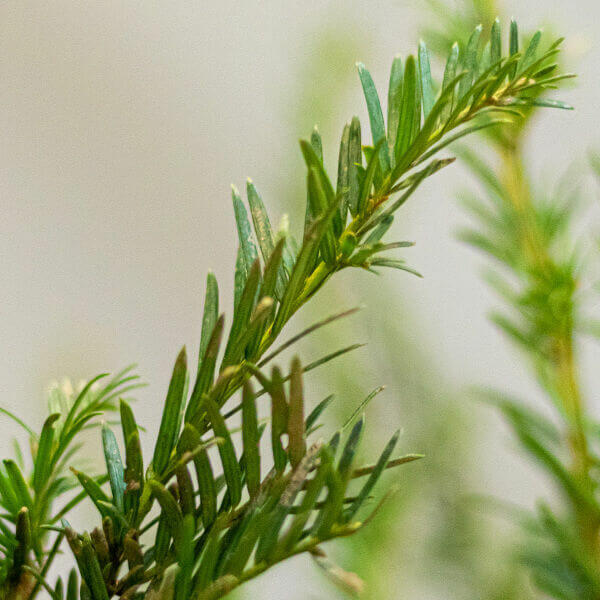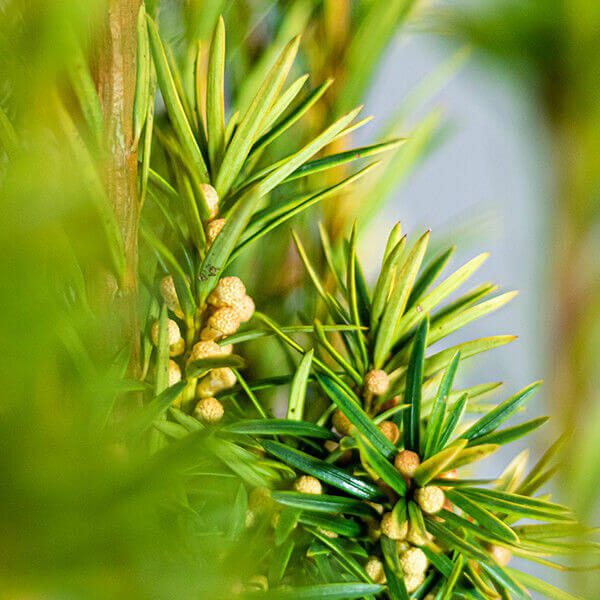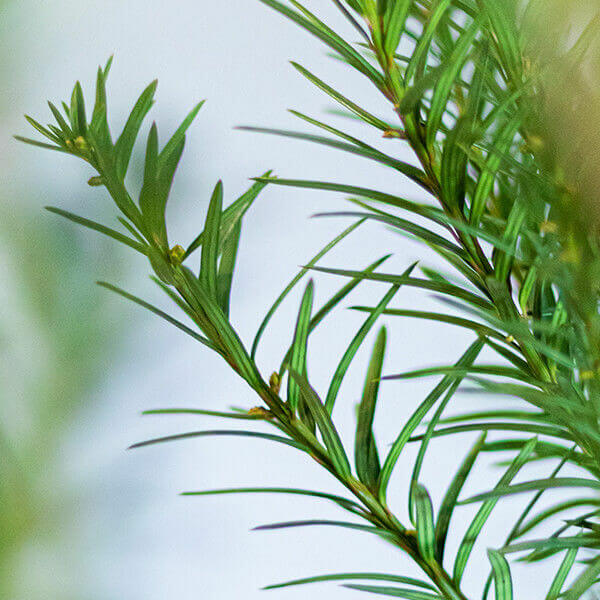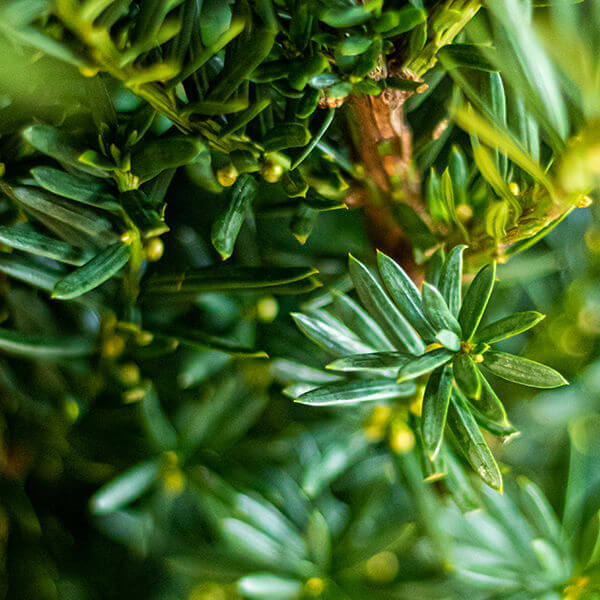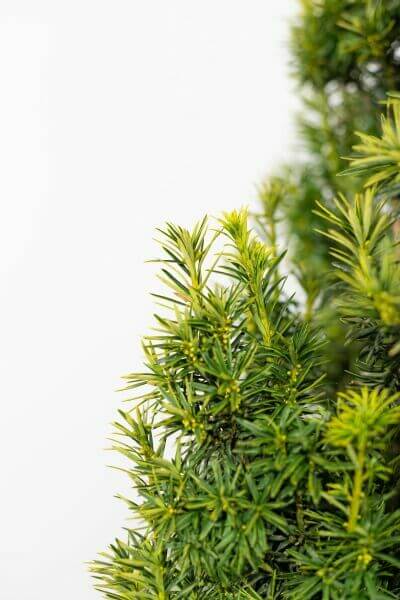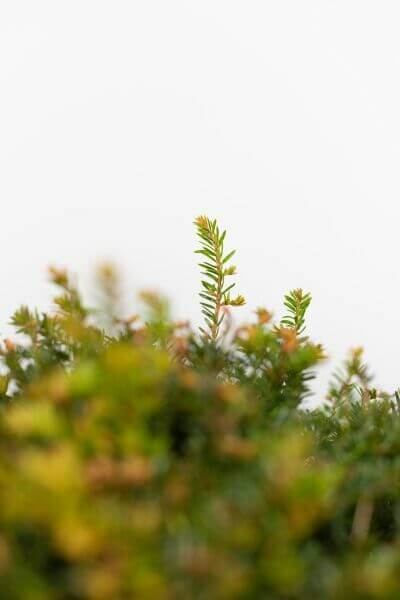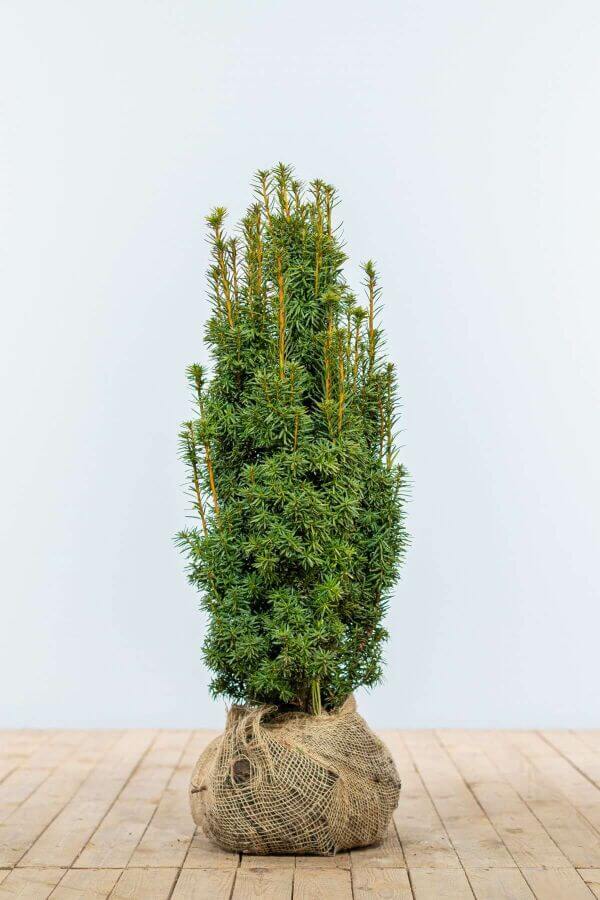Buy taxus
The yew hedge, also known as the English yew or common yew, is a popular evergreen hedge plant widely used in gardens. Since 1976, Heijnen has been cultivating yew hedge plants. This shrub belongs to the conifer family Taxaceae. Yew plays an important role in nature, as birds feed on the arils (fleshy seed coverings) and use the dense branches for nesting. Originally native to Europe, North Africa, and Western Asia, the yew has a rich cultural history. In Celtic and Christian traditions, the yew is regarded as a sacred tree, symbolising immortality. The life cycle of the yew is remarkable: it grows slowly, is shade tolerant, and can live for hundreds of years. In gardens, the yew is primarily used as a hedge plant, but it can also be planted as a specimen shrub (shaped into topiary such as yew balls or cones) and, when left unpruned, it can grow into an impressive coniferous tree. Yew is a robust, evergreen hedge plant that brings strong character to any garden. Its needles are glossy and dark green, while its reddish-brown bark peels slightly, adding extra texture to the landscape. During the inconspicuous flowering period in March, bright red berry-like seeds (Taxus baccata) appear, creating a striking contrast. Certain yew cultivars, such as Taxus × media 'Hillii', do not produce (toxic) berries. While the yew hedge is a beautiful and versatile evergreen, caution is advised due to the plant’s toxicity.
Characteristics and Growing Properties of a Yew Hedge
The yew hedge is one of the most popular and best-selling hedges at Heijnen. In addition to its excellent tolerance of pruning, its popularity is largely due to the outstanding qualities of the yew. This evergreen conifer grows relatively slowly and has a dense structure, providing both shelter and privacy in the garden. The yew is also highly shade tolerant and can live for several centuries. Growth begins with the emergence of dark green, glossy, flat needles. These needles remain on the plant throughout the year, ensuring that the hedge stays evergreen year-round. In March, inconspicuous flowers develop, followed by bright red fruits between April and May. The vivid red arils create a striking contrast with the deep green needles and are highly attractive to birds. However, while the berries may appeal to wildlife, the plant itself is toxic to children and pets. Care should therefore be taken when planting yew in family gardens. As long as it is not ingested, the yew is perfectly safe and highly effective as a garden hedge.
A yew hedge can grow in various soil types, though well-drained soil is ideal. The richer and more fertile the ground, the stronger and greener the hedge will become. When left unpruned, a mature yew hedge can reach between 1 and 20 metres in height. When trimmed, it can be shaped into neat, formal hedges ranging from small borders of around 30 cm to imposing garden screens several metres high. Proper positioning and care are essential for maximum growth, although yew tolerates shaded areas well and is resistant to air pollution. Its winter hardiness is exceptional, withstanding temperatures as low as -40°C, making it suitable for colder climates. Frost tolerance depends on both the chosen variety and soil conditions, with well-drained soil playing a crucial role in winter resilience. Beyond withstanding cold, yew is also remarkably tolerant of hot summers and dry conditions. Its wax-coated needles help retain moisture, while a deep root system enhances drought resistance. A tall yew hedge provides excellent shelter for birds and produces red arils that serve as a valuable food source, making it ecologically beneficial as well. By recreating natural habitats, yew hedges enhance biodiversity and contribute to a healthy garden ecosystem. In this way, the yew hedge not only adds timeless beauty but also brings extra life and ecological value to the garden hedge plant .
The Many Uses of Yew Hedges in the Garden
Thanks to its favourable characteristics, the yew hedge can be used in a variety of ways in the garden. While most Heijnen customers choose yew as a conifer hedge, there are many other applications possible. The hedge specialists at Heijnen have listed the most common uses below:
A yew hedge is evergreen, making it ideal as a boundary hedge to provide privacy in the garden.
With its compact and dense growth habit, a yew hedge also serves as effective wind and noise protection.
Because the common yew tolerates pruning exceptionally well, it can be shaped into low, elegant hedges along pathways, borders, terraces, or lawns.
In addition to low hedges in the front garden, yew can also be grown into taller hedges, perfect for screening unsightly objects such as containers or walls.
A yew hedge belongs in every classical and formal garden. It is a familiar feature in French-style gardens, castle grounds, and parks.
The yew hedge is perfectly suited for precise trimming into geometric shapes and symmetrical lines, creating a luxurious and formal appearance.
Beyond traditional shapes such as yew balls, cones, pyramids, or artistic topiary, yew can also be pruned into so-called ‘yew clouds’.
The yew hedge provides a valuable food source for wildlife as well as shelter and nesting opportunities for birds.
A yew hedge is relatively low-maintenance and slow-growing, making it an excellent choice for a sustainable garden.
A yew shrub can also be used effectively for creating structured planting schemes in the garden.
Discover our range of yew varieties below and choose the right type of common yew hedge to suit your garden and preferences.
Combining Yew Hedges with Other Garden Plants
Yew hedges can be easily combined with a wide range of garden plants, especially when used as a hedge. As a tall hedge, the common yew makes an excellent background planting and complements almost any other garden plant suitable for the given location. According to Heijnen’s plant experts, a particularly attractive combination is Taxus baccata with Salvia nemorosa ‘Caradonna’ and Hakonechloa macra 'Aureola'. The striking deep purple flowers of Salvia together with the variegated foliage of Hakonechloa contrast beautifully with the dark green needles of the yew hedge. As a low hedge along borders or pathways, yew also pairs wonderfully with coneflowers (Echinacea), lavender, lady’s mantle (Alchemilla mollis), and masterwort (Astrantia). Yew also combines well with ornamental grasses. From our experience, it looks especially appealing alongside perennials such as Liriope, Miscanthus, and Stipa, where the colours of the flower plumes and foliage harmonise perfectly with the deep green of the yew. In addition, the common yew pairs well with other evergreen hedging plants or flowering hedges. In practice, we have found that yew combined with Irish ivy (Hedera hibernica) or Japanese holly (Ilex crenata) is also highly decorative.
The Ideal Soil and Location for a Yew Hedge
Yew hedges grow well in both sunny and shaded areas of the garden. For optimal growth, it is important that a yew hedge receives at least 4 to 6 hours of sunlight per day. In addition to the right location, soil quality also plays a vital role in the health and vigour of the plant. Yew prefers well-drained, preferably lime-rich loamy soil that is sufficiently aerated, allowing excess water to drain away easily. If the roots of a yew hedge remain in waterlogged soil for too long, the common yew may develop root rot. Proper soil preparation before planting will help prevent future problems. On heavy clay soils, the ground should be loosened with sand or compost. On poor sandy soils, humus or compost can be added to improve water retention. This way, you avoid soil issues and provide a strong foundation for a healthy hedge. The ideal pH value is between 6.5 and 7.5 – a neutral to slightly alkaline soil – and yew hedges should be fertilised twice a year: once in early spring and again in June or July with, for example, Heijnen starter and maintenance fertiliser. Although yew hedges are reasonably drought-tolerant, they still require sufficient watering. After planting, it is important to water thoroughly to ensure good root establishment. Once established, the hedge can draw moisture from the soil itself, and watering is only necessary during prolonged dry periods. Always check the soil before watering to ensure it is truly required. To reduce soil dehydration, a mulch layer of bark chippings can be spread around the hedge, helping the soil retain moisture and protecting the roots from drying out.
Would you like to plant a yew hedge and enjoy a healthy, full hedge for many years? Make sure to provide:
At least 4–6 hours of sunlight per day.
A sheltered position protected from strong winds.
Well-drained, lime-rich loamy soil.
Adequate soil moisture and regular watering.
A pH between 6.5 and 7.5.
Annual fertilisation in spring and summer.
Expert tip: use Heijnen planting soil for optimal root development of your yew hedge.
Planting a Yew Hedge (Taxus baccata)
The best time to plant a yew hedge is in autumn or early spring. Container-grown yew plants can be planted throughout the year, except during severe frost when the soil is frozen. If you choose root-balled or bare-root yew plants, planting in spring or autumn is recommended, as the risk of drying out is lower and the hedge will establish more quickly. A dense, full hedge starts with the correct planting distance. The larger the yew plants at planting, the fewer plants you will need per metre. As a general guideline, you can use the following planting densities per linear metre:
Yew hedge 60/80 cm, 80/100 cm – 3 plants per linear metre.Yew hedge 100/120 cm – 2.5 plants per linear metre.Yew hedge 120/140 cm, 140/160 cm, 160/180 cm, 180/200 cm, 200/225 cm – 2 plants per linear metre.
Would you like to know exactly how many yew plants you need per metre of hedge? Please check the product specifications under planting details.
For successful growth, good preparation is essential. Yew thrives best in neutral to lime-rich, well-drained, and slightly moist soil. Enrich the ground with Heijnen planting soil or compost to provide additional nutrients. This promotes strong root development and ensures a healthy, vigorous hedge. After planting, it is important to water your yew hedge regularly, especially during dry periods. For a detailed step-by-step guide to planting a yew hedge, please see our hedge planting instructions .
Grower’s tip: would you like a beautiful, mature-looking yew hedge straight away? Choose larger container-grown or root-balled yew plants when planting.
Proper Care and Maintenance of Yew (Common Yew) Hedges
With the right care and maintenance, a yew hedge can thrive and last for decades – even centuries! This evergreen hedge plant is renowned for its longevity. To help you enjoy a healthy and beautiful hedge for many years to come, Heijnen’s plant experts have outlined the most important tips for caring for and maintaining your yew hedge below.
Planting a Yew Hedge
The best time to plant hedges is in spring (March/April) and autumn (September/October).
Container-grown yew hedge plants can be planted year-round, except during periods of severe frost.
Provide neutral to lime-rich, well-drained, and slightly moist soil.
Enrich the soil with compost or planting soil for extra nutrients.
Avoid wet, waterlogged sites to prevent root rot.
Watering a Yew Hedge
After planting, water generously to ensure the roots make good contact with the soil and establish properly.
During the first few months after planting, water regularly to prevent drying out and to help the hedge root effectively.
It is better to water deeply once or twice per week rather than a little every day (this encourages deeper root growth).
Once established, only water during prolonged dry periods. Even mature yew hedges should be watered in time to prevent drought stress.
Yew does not tolerate waterlogged soil (“wet feet”), so ensure proper drainage (thorough soil preparation is essential).
Pruning Yew Hedges
Pruning once or twice a year is sufficient for a dense, neat hedge.
The ideal pruning times are late May/June after the first growth flush, and/or late August/September to keep the hedge tidy before winter.
Trim the hedge slightly wider at the base than at the top to allow optimal light penetration and growth.
Prune regularly to avoid having to cut too deeply into old wood (although unlike many other conifers, yew does tolerate hard pruning).
Always use clean, sharp gardening tools (such as secateurs or hedge shears) to make pruning easier and more precise.
Fertilising a Yew Hedge
Fertilise in spring (March/April) and summer (July/August) to promote strong growth, plant health, and a rich dark-green needle colour.
Use Heijnen starter fertiliser when planting and Heijnen maintenance fertiliser for annual feeding.
Organic fertilisers or special conifer fertilisers are recommended. Avoid synthetic fertilisers, as incorrect use can cause leaf or root burn.
Compost or potting soil can be worked into the top layer annually (taking care not to damage the roots) to improve soil humus content.
If necessary (depending on soil pH), add lime if the soil is too acidic. Yew thrives in lime-rich soil.
For more detailed information about caring for and maintaining yew (common yew) hedges, please see this page under the section “Planting and Care”.
The Greatest Ornamental Qualities of Yew Hedges
The yew hedge (common yew) is among the most cherished hedge plants, valued especially for its ornamental appeal and unique characteristics. Its popularity can be attributed to the following features:
Evergreen: yew hedges retain their needles throughout winter, ensuring year-round greenery. This makes them the perfect boundary hedge for those seeking additional privacy in the garden.Durable: yew is an exceptionally strong hedge plant that, with proper care, can live for hundreds of years. This makes a yew hedge one of the most sustainable long-term investments for the garden.Dense and compact: although growth is slow (growth rate depends on the variety, typically several tens of centimetres per year), yew forms a very dense hedge. As a result, it provides excellent privacy and screening. Its thick branching also makes the common yew ideal as a windbreak and natural sound barrier in the garden.Versatile: yew can be used for both low and tall hedges and tolerates partial shade very well. It is therefore suitable for almost any garden. Beyond hedging, yew can also be shaped into topiary or grown as a tree, making it adaptable to virtually every garden style.Elegant appearance: unlike many other conifers, yew exudes calmness and sophistication. It is often planted in castle gardens, estates, and luxury villas, yet also brings a chic, refined character to modern urban gardens.Ecological value: yew hedges provide excellent shelter and nesting sites for birds and small animals, contributing to greater biodiversity. In addition, the red arils serve as a food source for certain bird species.Easy to prune: yew tolerates pruning exceptionally well, even hard pruning. If a yew hedge is accidentally cut back too severely, it will readily regenerate from old wood – something most other conifers cannot do. This allows shaping into virtually any form and height.Low-maintenance: although a yew hedge requires trimming once or twice a year, it is otherwise low-maintenance. Its slow growth means less frequent pruning compared to other hedge plants. It is rarely affected by pests or diseases and only needs additional watering during prolonged droughts.
Well-Known and Popular Yew Varieties for Hedges: An Overview
Heijnen Plants offers six yew varieties in its range, each perfectly suited for hedging. Below you will find more information about these varieties and their characteristic features:
Taxus baccata hedge (most commonly used): the Taxus baccata, also known as common yew, is the most traditional and well-known variety. This evergreen conifer has glossy dark green needles and is extremely hardy. Thanks to its slow growth rate (20–40 cm per year) and compact structure, it is ideal for forming neat, dense hedges that last for many years. It can be used for both tall and low hedges and provides a luxurious boundary in any garden. With its durability and classic look, Taxus baccata is one of the most widely used hedge plants.Taxus baccata 'David' hedge (golden shoots): the Taxus baccata ‘David’ is a striking variety with green foliage and distinctive golden-yellow shoots at the tips, giving it extra ornamental value. Like the common baccata, it is evergreen and very hardy, but grows slightly slower and more compactly. This makes it particularly suitable for smaller gardens or as a colour accent in a hedge or border. Its striking foliage colour also allows it to combine beautifully with other evergreen hedges.Taxus media ‘Hicksii’ hedge (with red berries): the Taxus media ‘Hicksii’ is a hybrid yew with an upright, dense growth habit. It remains more compact than common baccata, making it ideal for narrow, tall hedges. This variety retains its deep green needles year-round and is fully hardy. In autumn, female plants often produce red berries, adding ornamental value and attracting birds. With its slow growth rate (20–30 cm per year) and strong structure, Hicksii is a popular choice for formal hedges.Taxus media ‘Hillii’ hedge (without red berries): the Taxus media ‘Hillii’ closely resembles Hicksii, but as a male variety it does not produce berries. This makes it particularly suitable for those seeking a clean hedge without fruit. Hillii has deep green, soft needles, is evergreen, hardy, and slow-growing. Its dense, uniform growth makes it a highly popular, low-maintenance hedge plant that remains attractive for many years, even without frequent pruning.Taxus ‘Fastigiata Aurea’ hedge (columnar with golden shoots): the Taxus ‘Fastigiata Aurea’ stands out for its narrow, columnar growth and striking yellow-green to golden young shoots, contrasting beautifully with the darker mature foliage. This variety is slow-growing, evergreen, and very hardy. It is particularly valued as a specimen plant or garden feature, though it also looks stunning in formal plantings or combined with other yew varieties. Its unique colour brings vibrancy to any hedge or border.Taxus ‘Fastigiata Robusta’ hedge (columnar and compact growth): the Taxus ‘Fastigiata Robusta’ is a narrow, column-shaped yew with glossy dark green needles. It grows slowly but more densely and compactly than common baccata, making it ideal for narrow hedges and formal screens. This variety is fully hardy and retains its rich green colour throughout the year. With its upright, compact form, Fastigiata Robusta is especially suitable for smaller gardens or modern designs where space and elegance are key.
In addition to hedge varieties, Heijnen also offers the Taxus baccata ball , available in various sizes (diameters). These yew balls range from Ø 30 cm up to Ø 100 cm.
Advantages and Disadvantages of a Yew Hedge
Although yew hedges offer many benefits, there are also some drawbacks to consider. To help you decide whether a yew hedge is the most suitable choice for your garden, our hedge experts have listed all the advantages and disadvantages below:
Advantages
A yew hedge is evergreen and retains its deep green colour year-round, ensuring continuous structure and colour in the garden.
Thanks to its winter hardiness, yew withstands severe frost and is therefore suitable for colder climates.
With its long lifespan, a yew hedge is a sustainable choice for any garden.
Due to its compact growth, yew forms a dense privacy hedge and effective windbreak.
Yew is highly tolerant of pruning and can be easily shaped into neat hedges and formal lines.
Unlike many other conifers, yew will regenerate from old wood, even after hard pruning.
Its elegant appearance makes a yew hedge suitable for both modern and classical gardens.
Yew is highly versatile: it can be used as a tall hedge, low hedge, or as a specimen plant.
Its relatively slow growth means that a yew hedge requires little maintenance compared to faster-growing hedge plants.
Yew hedges provide shelter for birds and small animals, while the red arils can serve as a food source for certain bird species.
Disadvantages
Yew is toxic to humans and animals, so caution is advised in gardens with children or pets.
Compared to other hedge plants, yew grows relatively slowly.
The common yew is sensitive to waterlogged soil and does not tolerate prolonged “wet feet”.
Buying a Yew Hedge? Delivered Directly from the Nursery
Buying a yew hedge is easy and affordable online at Heijnen. Since 1976, the Heijnen family has been cultivating a wide range of hedge plants, including Taxus baccata. This popular hedge plant is ideal for almost any garden and is delivered directly from our nursery. This way, you are always assured of top-quality plants at a competitive price. The yew hedge is evergreen, extremely hardy, and has a naturally compact growth habit. As a result, you can create a dense, elegant hedge that lasts for decades while providing a stylish green appearance throughout the year. Do you have any questions or would you like expert advice about buying a yew hedge? Feel free to contact our experienced plant specialists by email or telephone.
Buy your yew hedge directly from the grower and benefit from:
Top-quality yew hedge plants, grown on our own soil.
Carefully delivered to your home within just a few working days.
Tailored advice from experienced plant specialists.
Alternative Hedge Plants for the Taxus
Would you prefer a different type of hedge than the taxus? Then discover our popular and possible alternatives here:
